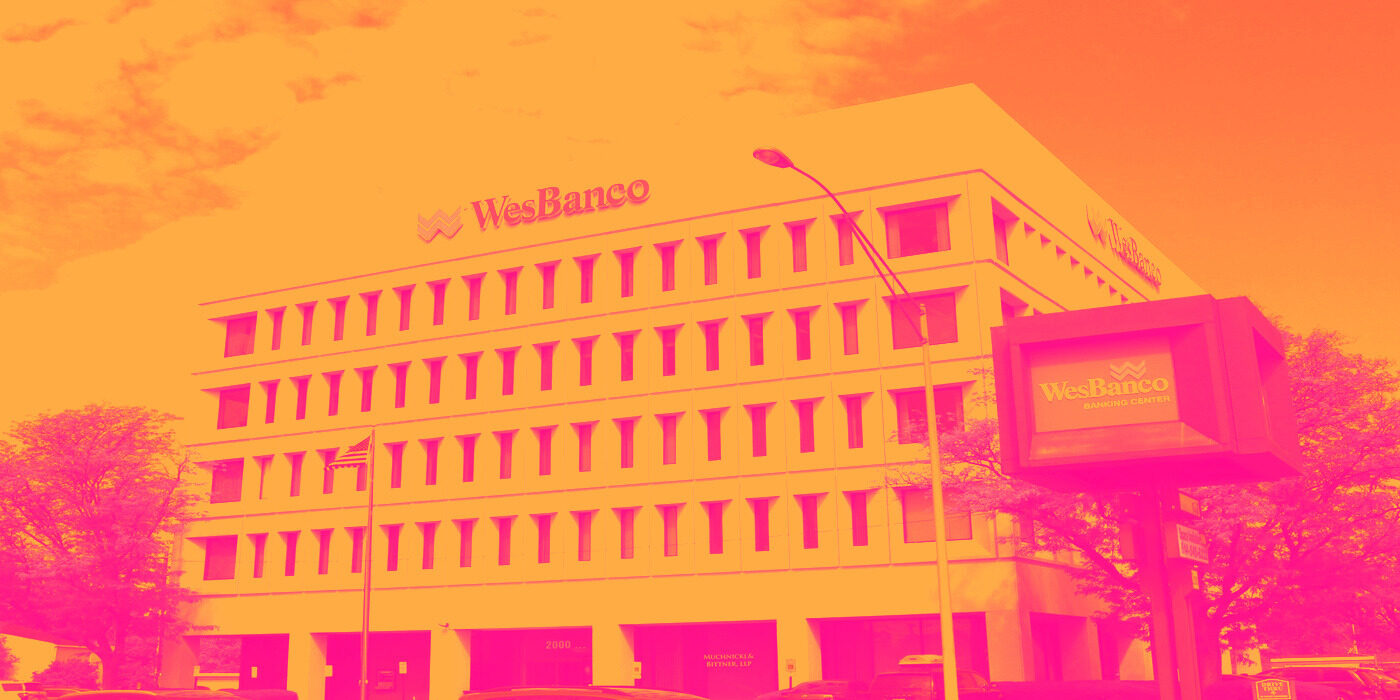
Regional banking company WesBanco (NASDAQ:WSBC) fell short of the market’s revenue expectations in Q1 CY2025, but sales rose 33.6% year on year to $193.2 million. Its non-GAAP profit of $0.66 per share was 16% above analysts’ consensus estimates.
Is now the time to buy WSBC? Find out in our full research report (it’s free).
WesBanco (WSBC) Q1 CY2025 Highlights:
- Revenue: $193.2 million vs analyst estimates of $197.9 million (33.6% year-on-year growth, 2.4% miss)
- Adjusted EPS: $0.66 vs analyst estimates of $0.57 (16% beat)
- Market Capitalization: $2.88 billion
StockStory’s Take
WesBanco’s first quarter results reflected the impact of its recent acquisition of Premier Financial and ongoing organic loan and deposit growth. Although the company missed Wall Street’s revenue expectations, management pointed to improved net interest margin and operational efficiency as key drivers. CEO Jeffrey Jackson emphasized that “strong organic loan and deposit growth” was achieved while integration efforts with Premier progressed, and the bank’s balance sheet benefited from deposit-funded loan growth and reduced reliance on higher-cost borrowings.
Looking ahead, WesBanco’s guidance is anchored by expectations of continued margin improvement, disciplined cost management, and full realization of cost synergies from the Premier integration. Management expects loan growth to be fully funded by deposit growth and highlighted their outlook for stable credit quality across a diversified footprint. CFO Daniel Weiss stated that most of the cost savings from the merger should be reflected by the third quarter, with the expense run rate stabilizing thereafter. The company remains cautious about external risks, including potential impacts from tariffs, but believes it has limited exposure to these uncertainties due to portfolio diversification.
Key Insights from Management’s Remarks
Management identified the Premier Financial acquisition and robust organic loan and deposit growth as primary influences on first quarter performance, with attention also given to margin improvement and balance sheet restructuring.
-
Premier Financial acquisition: The closing of the Premier deal immediately expanded WesBanco’s asset base, making it one of the 100 largest U.S. banks by assets. Management retained nearly 90% of Premier’s employees, aiming to leverage their local expertise and customer relationships for broader market reach.
-
Margin and efficiency gains: Net interest margin increased to 3.35%, aided by higher loan and securities yields, lower funding costs, and purchase accounting accretion from the acquisition. The efficiency ratio also improved, reflecting early benefits from merged operations and cost discipline.
-
Loan and deposit funding strategy: Organic loan growth was fully funded by organic deposit growth, reducing dependence on higher-cost brokered borrowings. Commercial loans, especially in commercial real estate, and deposits grew across nine states, with the commercial loan pipeline strengthened by both legacy and Premier operations.
-
Balance sheet restructuring: The company restructured Premier’s securities portfolio, replacing lower-yielding assets with higher-yielding securities and paying down expensive borrowings. This repositioning supported immediate margin expansion and improved asset yields.
-
Expense base and integration costs: Non-interest expenses rose due to the addition of Premier’s operations and higher software costs while running two core systems. Management expects expense synergies to materialize after the core system conversion in mid-May, with full cost savings anticipated by the third quarter.
Drivers of Future Performance
Management’s outlook centers on successful integration of Premier, continued margin expansion, and disciplined expense management amid ongoing economic and industry uncertainties.
-
Integration and cost synergies: The core system conversion and operational integration with Premier are expected to deliver most of the planned 26% cost savings by the third quarter. Management aims to stabilize the expense run rate around $140 million for the remainder of the year, with additional savings realized after mid-year merit increases and platform consolidation.
-
Margin improvement and funding strategy: Margin expansion is projected to continue, driven by lower funding costs as certificates of deposit (CDs) reprice and higher-yielding loans and securities gradually replace legacy assets. Management anticipates that loan growth will remain fully funded by deposit growth, minimizing the need for wholesale borrowings.
-
Credit quality and external risks: The company expects credit quality to remain stable, supported by a diversified loan portfolio across multiple states and sectors. However, management remains attentive to macroeconomic risks, particularly the potential for trade-related tariffs to impact certain commercial clients, though current exposure is considered limited.
Catalysts in Upcoming Quarters
Going forward, our team will be monitoring (1) the successful completion of the core system conversion and realization of integration cost savings; (2) ongoing trends in organic loan and deposit growth, especially as they relate to funding strategies and market expansion; and (3) the impact of evolving economic conditions, including potential changes in interest rates and trade policy, on both credit quality and margin performance. Execution against these priorities will be key to tracking WesBanco’s progress post-merger.
WesBanco currently trades at $30.25, up from $29.93 just before the earnings. Is the company at an inflection point that warrants a buy or sell? See for yourself in our full research report (it’s free).
Stocks That Trumped Tariffs
Market indices reached historic highs following Donald Trump’s presidential victory in November 2024, but the outlook for 2025 is clouded by new trade policies that could impact business confidence and growth.
While this has caused many investors to adopt a "fearful" wait-and-see approach, we’re leaning into our best ideas that can grow regardless of the political or macroeconomic climate. Take advantage of Mr. Market by checking out our Top 9 Market-Beating Stocks. This is a curated list of our High Quality stocks that have generated a market-beating return of 183% over the last five years (as of March 31st 2025).
Stocks that made our list in 2020 include now familiar names such as Nvidia (+1,545% between March 2020 and March 2025) as well as under-the-radar businesses like the once-micro-cap company Tecnoglass (+1,754% five-year return). Find your next big winner with StockStory today.
